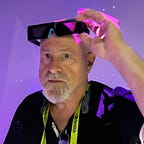Facebook Releases Blockbuster App For Remote Work
This morning Facebook launched Horizon Workrooms, a free cross-platform XR (VR, PC) collaboration app that enables distributed teams or groups to share a private virtual room for meetings, training, and education. Workrooms can accommodate up to sixteen avatars, representing sixteen people in Oculus Quest 2 VR headsets, and as many as fifty people on video, using the companion Oculus remote desktop PC app, which provides a Zoom-like interface for colleagues on PCs in the physical world. There are whiteboards, shared note pads, and options for multiple environments that change in size based on the number of participants in VR. The rooms are persistent and content created there can be taken back onto the PC. Users can upload documents, photos, videos, basically any file on their computer into the room. You can even screen share.
Using a combination of converging technologies like avatar animation, computer vision, and mixed reality, the London-based team led by Workrooms Lead Mike LeBeau has created something astonishing. You can see your computer through the outward-facing cameras of the Quest 2 headset well enough to type notes on a real computer while in VR, as I did during yesterday’s press conference in Workrooms with LeBeau and the head of Facebook Reality Labs, Andrew “Boz” Bosworth.
“Workrooms is our first experience designed from the ground up using hands as your primary form of input instead of controllers,” began LeBeau. “Hands, as it turns out, are really great for productivity experiences. They’re more natural, more expressive, and quite good for using other tools like whiteboards and computers, making it more like a place you want to do work.”
“We think of Workrooms not just as a virtual reality experience but as a mixed reality experience, which means we’re blending some elements of the real world with the virtual world, so ideally you get the best of both worlds,” LeBeau explained. “You don’t have to leave regular tools like your computer behind, you can bring them with you and be more productive.”
In his opening remarks, Bosworth said Horizon Workrooms has within it “a hint about the direction the metaverse is headed… [Workrooms] isn’t the metaverse itself, it’s a universe we’ve created, but it is a step in the right direction. You’ve got avatars and you’ve got identity that is continuous and you can take it with you. It works for people in 2D and in headsets.” Boz later elaborated. “Consider the experience of the person calling in on video. They’re not in VR. A metaverse describes a persistent digital place that can be accessed by all sorts of devices. It only really becomes a metaverse when it crosses platform boundaries.”
I have written a book on Remote Collaboration, and have visited, literally, hundreds of sites, and used dozens of apps, but I have never seen anything like Workrooms. I keep up with the leading state-of-the-art cross-platform virtual collaboration platforms like Spatial.io, Altspace, Engage, Glue, Arthur, and Virbela, which all seem to be growing quickly. They offer all the features Horizon Workrooms has and more. Even though Workrooms was in production since before the pandemic according to Bosworth, the incumbent platforms have some important features that Workrooms doesn’t yet have. The interface Spatial, Engage, and Altspace all have with VR world-building platforms Unreal Engine and Unity, don’t exist on Workrooms.
Workrooms is formally called “Horizon Workrooms,” because it is tied to Facebook social VR app Horizon, which is still in closed beta (invitation only). Therefore, this is one of the first times people can have a good look at the new Facebook avatars, which are a breakthrough in themselves. Who else has cheek movement? It is social presence, said Bosworth, that makes the whole thing work. Making avatars “was by far the hardest part” he said.
Workrooms is clearly still in beta, but it’s a beta of one of the most amazing things I’ve seen in VR. It just doesn’t happen to be working perfectly right now. My keyboard disappeared intermittently. Sometimes the hands occluded the keyboard and confused the computer vision. People had to log in and out to activate their audio. The biggest challenge is connecting the Workrooms desktop app with the headset. What is supposed to be automatic rarely is. Also, third party apps like Workrooms are not permitted on many company computers.
“We think of workrooms as a unique inflection point for VR. We’ve talked for a long time about future computing platforms. This is one of those moments when we think we’re starting to adapt the medium to that end for real, bringing together different technologies to create a new experience in VR. In doing so, we’re designing and building new interaction paradigms and foundations for what we think will be at the core of this new computing platform,” said LeBeau.
Originally published at https://www.forbes.com.
